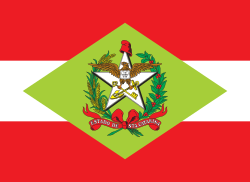 | |
| Use | Civil and state flag |
|---|---|
| Proportion | 8:11 |
| Adopted | 29 October 1953 |
| Design | A red and white horizontal tricolour, with a lime green lozenge in the centre featuring the coat of arms [1] |
| Designed by | Irineu Bornhausen [1] |
The flag of Santa Catarina is the official flag of the Brazilian state of Santa Catarina. The flag was adopted on 29 October 1953 by State Law No. 975 under governor Irinieu Bornhausen. [1]
Contents

 Flag of Santa Catarina, used between August 15, 1895, and November 10, 1937
Flag of Santa Catarina, used between August 15, 1895, and November 10, 1937


